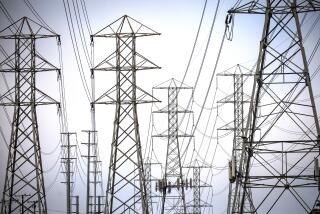Car Phone Market Is a Busy One : High Costs Aside, San Diego a Leader in Penetration
- Share via
Growing recognition of the cellular telephone’s value has spurred ever-increasing numbers of San Diegans to take the portable units on the road, helping make Southern California the biggest cellular phone market in the nation.
More than 50,000 San Diegans subscribe to cellular telephone service--a 2.27% penetration rate of the potential cellular phone market, one of the highest rates in the country and ahead of the 1.7% nationwide, industry analysts say.
But cellular phones are not for everyone. From 15% to 30% of subscriptions are canceled annually, an alarmingly high “churn rate,” experts say. Although several factors contribute to the high disconnection rate, “bill shock” appears to be the primary cause for customer disenchantment.
Fourth-Highest Rates
That shock can be particularly acute for cellular users in San Diego, which has the nation’s fourth-highest monthly service rates, behind Los Angeles, San Francisco and New York, according to industry figures.
The good news is that the cost of cellular phone “hardware” has dropped dramatically: A standard model that sold for nearly $2,000 five years ago costs as little as $400 today. But hefty monthly service bills can empty customers’ pockets in a hurry, said Andrew Roscoe, a senior consultant at Arlington, Va.-based Economic Management Consultants International, which specializes in mobile communications research.
“ ‘Man, I didn’t think I was going to spend that much’--that’s a typical customer reaction when they see their first couple of bills,” said Roscoe, adding that the average cellular user pays monthly bills of more than $100 in addition to his home and business phone tabs.
PacTel Cellular and U.S. West Cellular of California, the two companies that provide cellular phone service in San Diego County, charge their customers 40 cents a minute during weekday peak hours (7 a.m. to 7 p.m.). During off-peak hours, customers pay 20 cents a minute. Customers also pay a $35 monthly service charge.
At such rates, a local customer would pay $135 for 250 minutes of peak call time--higher than the $123 average for the 10 major cellular phone markets, said Herschel Shosteck, a telecommunications economist with Herschel Shosteck Associates Limited in Silver Springs, Md.
Although lower than the $157 charged in Los Angeles and San Francisco, and below New York’s $143, standard rates in San Diego are substantially higher than the $90 users would pay in Detroit or the $92 in Chicago.
Penetration Linked to Rates
“Detroit has the highest penetration rate--2.5%--and that’s directly linked to their low rates,” Shosteck said. Los Angeles and San Francisco have some of the lowest penetration rates: 1.47% and 1.27%, respectively.
Despite the costs, PacTel and U.S. West are rapidly signing up new customers, bolstering nationwide user totals that now exceed 2.1 million. Even with high rates, San Diego’s 2.27% penetration rate is among the highest in the country, trailing only Detroit (2.55%) and Boston (2.29%). Several telecommunications experts predict that the San Diego cellular phone market will grow at a robust 40% clip this year.
“The cellular phone market is dynamite in San Diego,” said Lap Lee, a telecommunications analyst at Salomon Brothers.
In general, Lee and other industry analysts say that trendy, “out-and-about” Southern Californians who spin their odometers on seemingly endless freeways make for the perfect cellular phone user.
At the end of 1988, Los Angeles had more than 200,000 cellular phone users, more than any other city in the United States. This year, Los Angeles is expected to hold on to its No. 1 ranking, with San Diego projected 11th in total users, Roscoe said.
Increasingly better technology and smaller and less expensive phone models will mean more business for PacTel and US West, both subsidiaries of major telecommunications companies.
Competition Ensured
When the Federal Communications Commission established the cellular phone industry in 1983, it granted two cellular franchises per market, ensuring a competitive environment and service.
Cellular service began in San Diego in August, 1985, with the opening of PacTel Cellular--a subsidiary of Pacific Telesis, the San Francisco-based telecommunications company. In June, 1986, U.S. West Cellular, followed suit. The U.S. West Cellular division, based in Bellevue, Wash., provides service in 29 markets, and is a subsidiary of Denver-based U.S. West, one of the “Baby Bells” created after the 1984 breakup of AT&T.;
Now, when a call from a traditional phone is made to a cellular receiver, the phone company directs the call to a cellular carrier’s “mobile telephone switching office.” The “MTSO” then sends the call to a radio tower positioned in a “cell site” that blankets the county. The call is then sent to the tower nearest the receiver, converted into a radio signal and broadcast to the cellular phone.
As a mobile receiver moves out of one cell site tower’s range, the call is automatically switched to the next nearest tower so that the call can continue uninterrupted.
Subscribers can now use their cellular phones outside of a typical coverage area, thanks to “roaming agreements” in which competing cellular carriers have agreed to accept and broadcast calls made from subscribers who don’t belong to their networks.
For example, when a local cellular subscriber is traveling in Chicago, he or she can still use a portable phone by having calls routed through Cellular One, one of Chicago’s carriers.
Long-Distance Costly
Through their own networks, or through roaming agreements, both San Diego carriers can provide service in more than 300 U.S. cellular markets. But long-distance cellular service is expensive: customers are typically charged a $2 daily access fee to use the foreign network and an average rate of 60 cents per minute.
Such high user fees and a cellular phone’s price tag still make the instrument a luxury for most.
“You won’t see the dramatic price drops for (standard phones) anymore,” Roscoe said, “You won’t see a $200 phone next year.”
But recently introduced high-technology, pocket-size phones will experience steep price cuts, he and other industry experts say. And the advent of these smaller phones, such as the Motorola Micro-TAC now on the market, will attract more customers.
“This isn’t just suitcase-friendly, it’s pocket-friendly,” said Fred Moran, president of Fred Moran & Associates, an investment banking firm in Greenwich, Conn., that has followed the cellular industry since its creation.
“If you don’t think that makes a major difference, let me ask you this: Would you rather carry around a clock or wear a wristwatch?”
The phone sells for more than $2,500 now, but Moran predicts that, by early next year, it will be nearly 50% cheaper.
The way he sees it, it’s only a matter of time before every American has a cellular phone. Moran envisions cellular phones in five years that can be strapped to an individual’s wrist--just like a watch.
“We’ll be just like Dick Tracy, talking on our wrist phone,” he said. “Before you know it, the traditional phone will become practically obsolete.”






